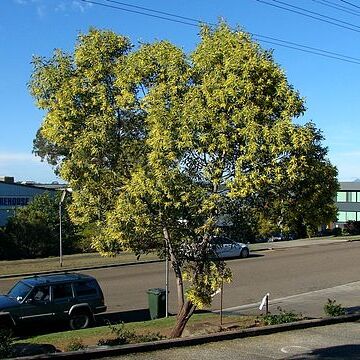Shrub or tree to 10 m high, single-stemmed, ±glaucous, glabrous. Bark longitudinally fissured, fibrous, grey-black. Branchlets angular, stout, brown, scurfy. Phyllodes oblique, very narrowly elliptic to narrowly elliptic, flat, with upper margin curved and lower margin straight, 8–16 (–18) cm long, (9–) 12–35 (–60) mm wide, coriaceous, ±scurfy when young, with (2–) 3–4 (–5) longitudinal veins more prominent (lower 2 confluent with each other near base); minor veins 3 or 4 per mm, strongly anastomosing; gland 1, basal, to 2 mm above pulvinus. Spikes 3.5–11 cm long, pale yellow. Flowers 5-merous; calyx 0.6–1 mm long, dissected to ⅙–⅕ of its length, with a few hairs near base; corolla 1.8–2 mm long, dissected to ½ of its length, glabrous; ovary pubescent. Pods linear, slightly moniliform, semicircular, 5–10 cm long. Seeds longitudinal, elliptic, 3.5–4.5 mm long, brownish black; pleurogram without halo; areole open, oblong.
More
A medium sized shrub. The young shoots have short hairs. The leaves (phyllodes) are 10-20 cm long and 2-3 cm wide. They are narrow and tapering at each end and curved like a sickle. They are smooth without hairs. They have 3-5 prominent veins. The flowers are rod like and 5-10 cm long. They are bright yellow. The pods are 10 cm long by 0.5 cm wide. They are thin and slightly twisted.


